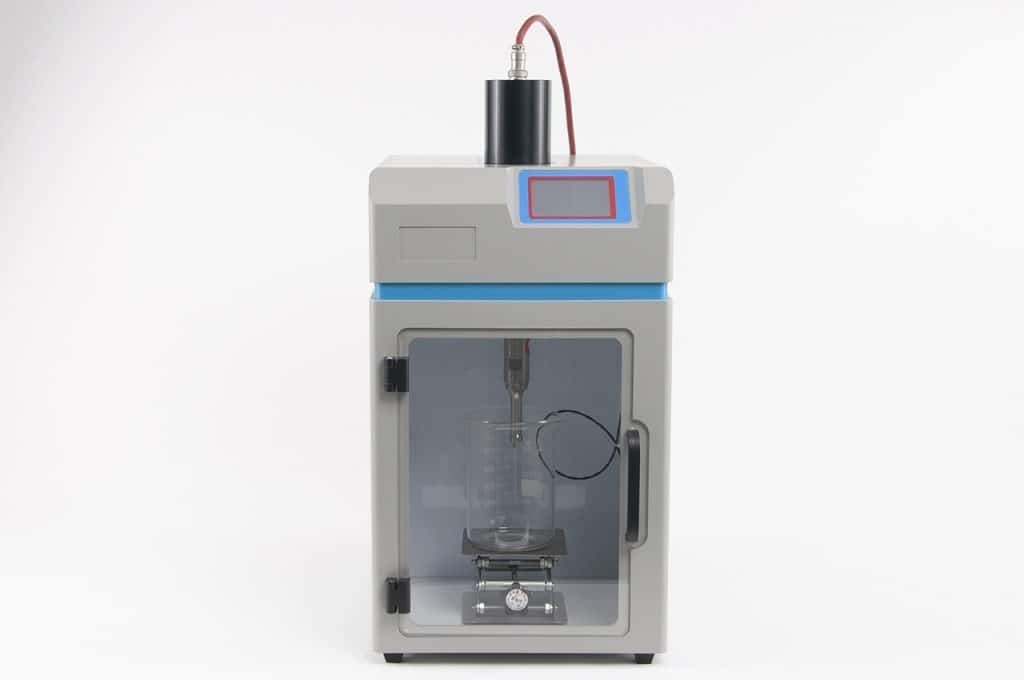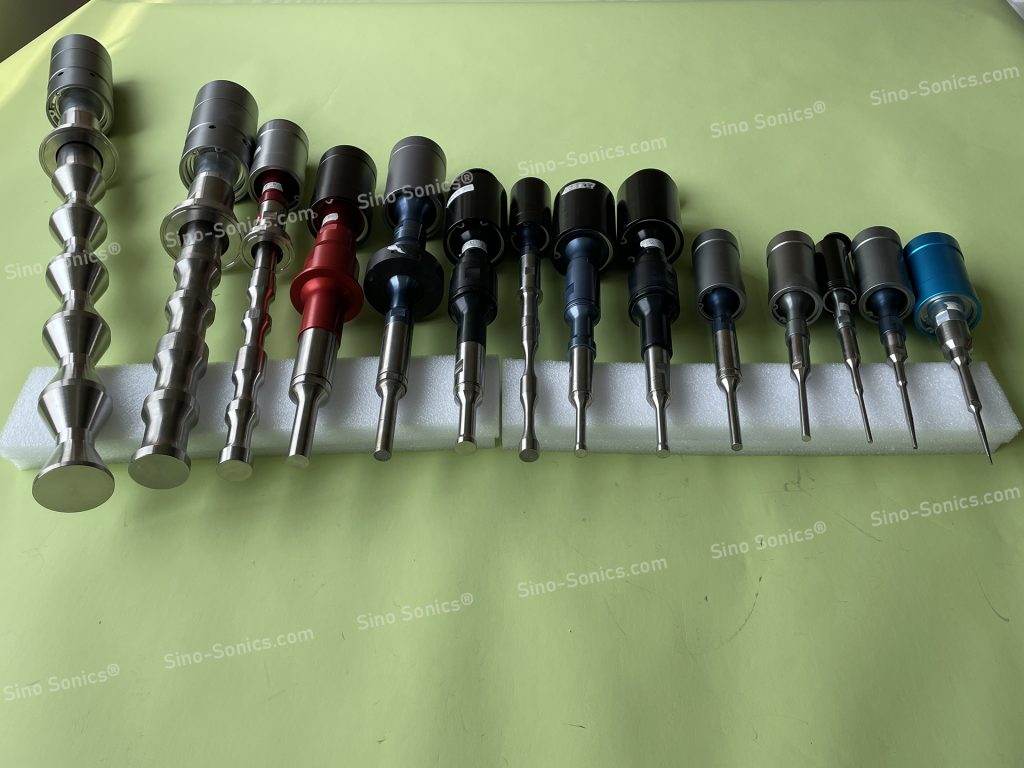Sample Volume and Probe Size
Selecting the proper size probe is extremely important. Each probe has an approximate recommended sample volume range. See the chart below for guidance. For example the ½” probe can process approximately 20-250ml. Depending on the vessel size and shape, the ½” probe may have difficulty fitting inside a 20ml volume and a microtip may be a better option. Sample vessel size and shape is a factor when selecting a probe.
Small volumes require a small tip to fit inside the sample tube. Small tips (microtips) are recommended for processing samples inside small, thin vessels and never samples larger than 50ml. Microtips are high intensity and made for short processing times. A microtip will generate a considerable amount of heat in small volumes and therefore should be used in the pulse mode to prevent heat buildup.
Larger volumes require a larger probe for effective processing. For example a 1” probe will process 1 liter more quickly than a ¾” probe. Using the proper size probe will not only reduce the processing time but increase the lifespan of the probe. Note when processing 1L or more, using a stir bar can increase a probeʼs processing volume.
While there is no absolute sample volume range for any probe/horn, to the right is a general guideline to follow. Processing volumes are application specific. Contact us for more details.
| Probe Tip Diameter |
Process Volume Range |
Amplitude Microns |
Probe Length |
Materials final size |
|---|---|---|---|---|
| 1/16″ (1.6 mm) | 0.2 ml ~ 15 ml | 320 μm | 9 cm | 2 ~3 nanometer |
| 1/8″ (3.2 mm) | 0.5 ml ~ 25 ml | 180 μm | 14 cm | 3 nanometer |
| 1/4″ (6.4 mm) | 10 ml ~ 100 ml | 120 μm | 11 cm | 3 nanometer |
| 8.0 mm | 10 ml ~ 200 ml | 100 μm | 11 cm | 3 nanometer |
| 9.0 mm | 10 ml ~ 250 ml | 90 μm | 10 cm | 4 nanometer |
| 10.0 mm | 20 ml ~ 300 ml | 80 μm | 10 cm | 4 nanometer |
| 1/2″ (12.7mm) | 20 ml ~ 300 ml | 60 ~ 120 μm | 13 cm | 3 ~5 nanometer |
| 16.0 mm | 20 ml ~ 600 ml | 70 | 13 cm | 5 nanometer |
| 3/4″ (19.1mm) | 50 ml ~ 800 ml | 60 μm | 28 cm | 5 nanometer |
| 20.0 mm | 50 ml ~ 900 ml | 55 ~80 μm | 28 cm | 7 nanometer |
| 1″ (25.4mm) | 100 ml ~ 1000 ml | 35 μm | 28 cm | 7 nanometer |
| 30.0 mm | 100 ml ~ 3 litre | 35 μm | 30 cm | 8 nanometer |
| 40.0 mm | 1000 ml ~ 25 litre | 25 μm | 30 cm | 10 nanometer |
| 50.0 mm | 1000 ml ~ 30 litre | 30 μm | 50 cm | 10 nanometer |
* Depends on the frequency & probe design, the vibration amplitude will also change accordingly. however, the principle & philosophy is same.
* The processed material’s final size depends on the processing duration time, and material’s characteristics & propertites.
* The probe length & total length will be different according to frequency & design.
* The probe length & tip diameter are all customizable.
Replaceable vs. Solid Tips
Replaceable tip probes are used with aqueous samples. Replaceable tip probes have threaded ends and when the tip is worn out it can be unscrewed and replaced.
If you sonicate a solution that contains organic solvents, alcohols or any low surface tension liquid, the liquid will seep inside this threaded tip (regardless of how tight the connection is attached). Once liquid gets inside the tip, it will loosen and cause the Sonicator to overload. If you are processing a sample containing solvents or low surface tension liquids you must use a solid tip probe. Solid tip probes can be used for any type of sample.
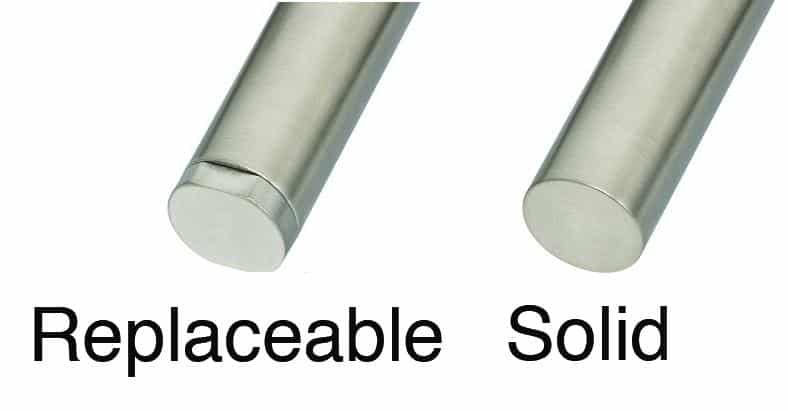
How to Safely Clamp a Converter
Improper clamping can damage the system and void the warranty. The photo on the right shows the clamp attached to an active portion of the converter which will be detrimental to performance and potentially damage the sonicator.
Note: Using a sino sonics customized enclosure or stand will ensure a proper fit.
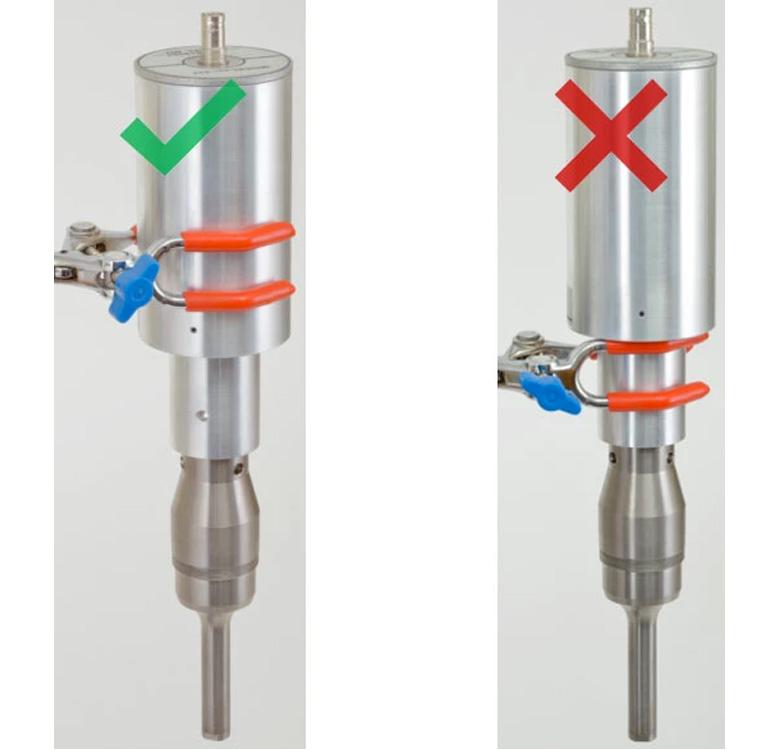
Tip Depth / Foaming Issue
Probes/tips must be submerged properly. If the tip is not submerged enough the sample will foam or bubble. If the tip is too deep it will not circulate the sample effectively. Both conditions will end up with poor results. Foaming often occurs with samples volumes below 1ml. Foaming can also be caused when the amplitude setting is too high.
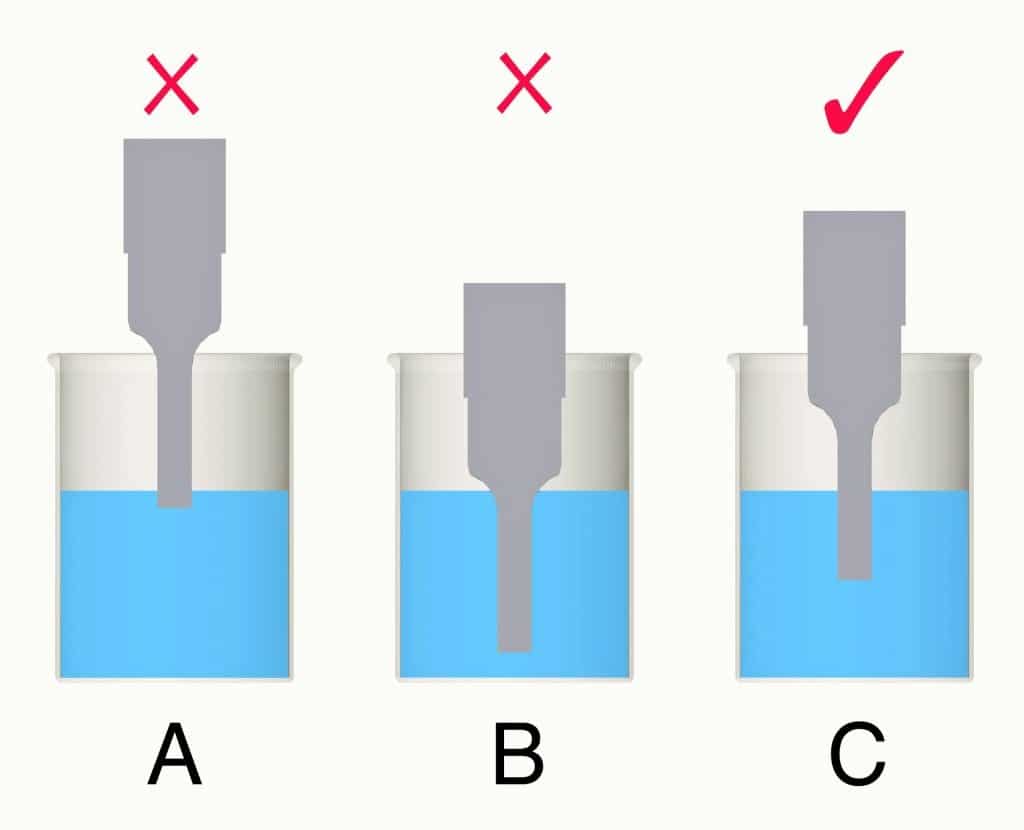
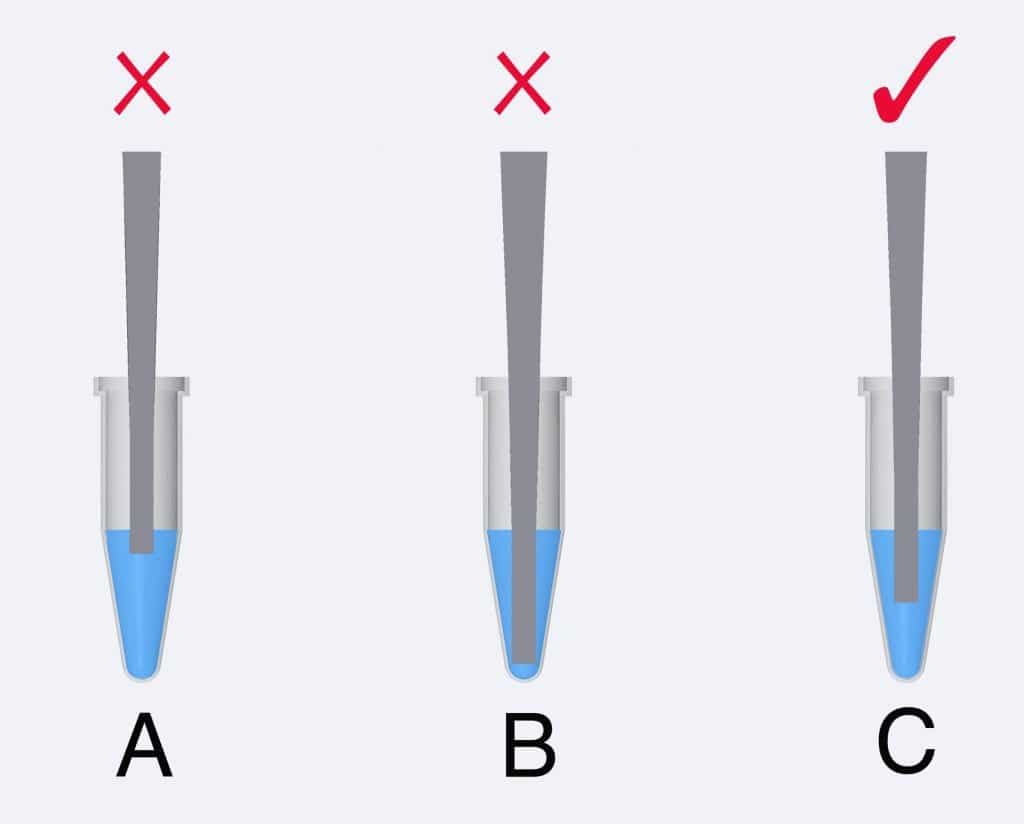
In the drawings above: Figure A will create foam and will not process the sample. Figure B will not circulate the liquid effectively and therefore will not process the sample. Figure C indicates the correct set up and will achieve good results in the shortest processing time.
Many customers place tubes in ice (to control temperature) making it difficult to see the tip. We recommend filling a tube with water to match your desired sample volume.
Insert the microtip to the optimum depth. Draw a horizontal line on the microtip with a permanent marker to indicate where to stop inserting the tip. By using the mark on the probe you can ensure the correct tip depth each time when the tube is submerged in ice.
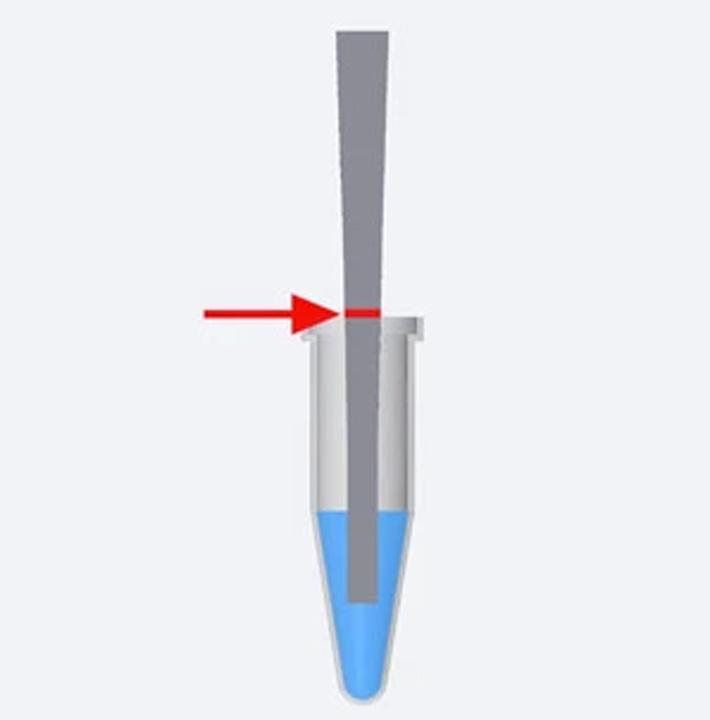
Vessel Shape and Size
A narrow vessel is preferable to a wide vessel. The ultrasonic energy is generated from the tip and is directed downward. As a sample is processed the liquid is pushed down and away in all directions. If the vessel is too wide it will not mix effectively and some sample will remain untreated at the periphery. Twice the volume in a narrow vessel takes a shorter time to process than the same volume in a wider vessel. In addition, the probe should never touch the sides or bottom of a vessel.
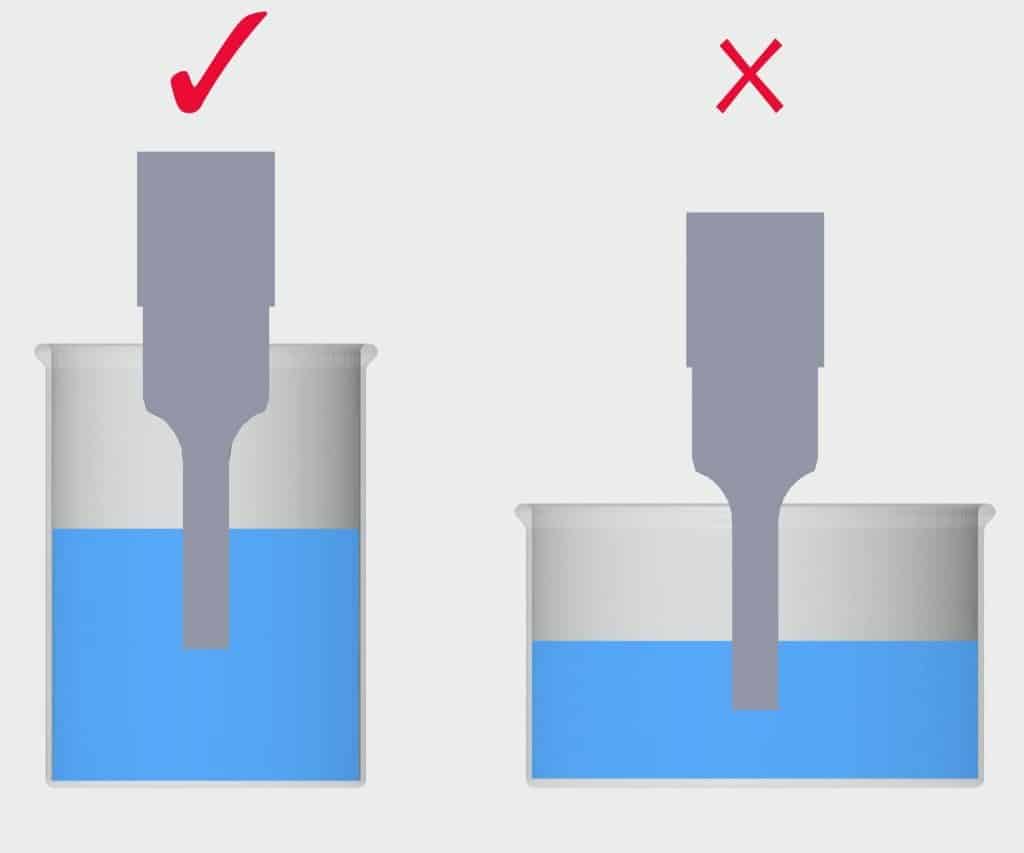
Power vs. Intensity
Power is the measure of the electrical energy that is being delivered to the converter. It is measured in watts and displayed on the sonicatorʼs screen. At the converter, the electrical energy is transformed into mechanical energy. It does this by exciting the piezoelectric crystals causing them to move in the longitudinal direction within the converter. This conversion from electrical into mechanical energy causes a motion that travels through the horn/probe causing the tip to move up and down.
The distance of one movement up and down is called its amplitude. The amplitude is adjustable. Each probe has a maximum amplitude value. For example, with a ½” diameter probe at setting 100%, the probe will achieve an amplitude of approximately 120μm. At setting 50% the amplitude is approximately 60μm. Note this value is approximate and not perfectly linear. Qsonica measures the amplitude of each probe at 100% and these values are published in the brochure.
Amplitude and intensity have a direct relationship. If you operate at a low amplitude setting, you will deliver low intensity sonication. If you operate at a high amplitude setting, you will have high intensity sonication. In order to be able to reproduce results, the amplitude setting, temperature, viscosity and volume of the sample are all parameters that need to remain consistent. The amplitude, not the power, is most critical when trying to reproduce sonication results.
Power has a variable relationship with amplitude/intensity. For example, sonicating water at setting 50% requires less wattage when compared to a viscous sample (such as honey). For both samples the amplitude/intensity is the same but the power/wattage will differ because the viscous sample will require more watts in order to drive the horn. The viscous sample puts a heavier load on the probe so they system must work harder to vibrate up and down at the same intensity.
Small fluctuations in the wattage display during sonication is normal. Major swings in wattage (+/-20 watts) may indicate a problem with the sample, setup or the sonicator itself.
Nanomaterials and Probe Size
Certain applications such as processing nanoparticles, often require long processing times. Using a larger probe will speed up processing and larger probes will not erode as quickly as smaller ones.
For example, using an Integrated Type Homogenizer with a ½” diameter probe will process a 50ml sample much faster than same Integrated Type Homogenizer with a ¼” probe. In addition, smaller probes wear out faster and will need to be replaced more often. Over time using a larger system will end up costing less as you factor in the replacement cost of multiple probes.
Optimization
1. All applications require optimization of amplitude and time settings. Test your probe/tip with water using the same volume and sample vessel that you will use for actual sample processing. Observe how the liquid moves during sonication at different amplitude (intensity) settings. You should see and hear the cavitation and the entire sample volume should mix and flow well.
2. Choose an amplitude setting that does not create foam or splashing as your starting point. Smaller volumes will require lower amplitude settings and shorter pulses of sonication. Larger volumes can be sonicated at 100% if necessary, to speed up processing times.
3. After choosing an amplitude setting, perform a time study by testing a sample at several time intervals and comparing results. Adjust amplitude and time as needed to obtain the desired result.
4. Contact our aftersales team for Protocols and Papers from other customers.
Controlling Temperature
There are many options for keeping samples cool during sonication:
- Use the pulse mode.
- Use ice along with the pulse mode.
- Coolracks chill samples and prevent movement.
- Chillers provide additional cooling capacity.
- Standard probes are approved for liquids up to 140°F.
Cooling the Converter
Sonicating for long time periods causes heat to transfer up the probe to the converter. Overheating can severely damage the converter and Homogenizer/Sonicator system. Hence, Sino Sonics designed for heavy duty working transducer/converter, integrated with cooling fan inside. for our customer’s 24×7 working.
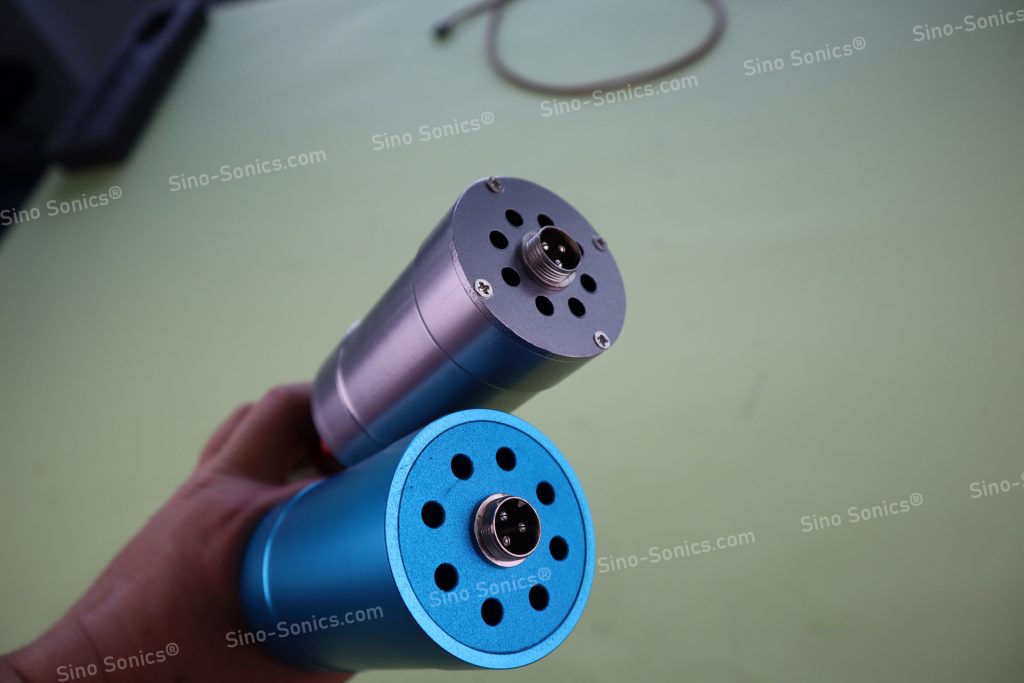
Booster Horn
A booster is a device that increases the amplitude (intensity) of a 1” or ¾” probe. For example, a 1 liter sample may be processed twice as fast with a 1” probe and 2:1 booster when compared to the 1” probe used alone. Smaller diameter probes already offer high intensity and will crack if used with a booster. The booster is recommended when processing difficult samples with volumes above 500ml.
How to Determine Energy Delivered
The WATTS reading displayed on the screen is the amount of electrical energy the ultrasonic generator delivers to the converter.
NOTE: The greater the resistance to the movement of the probe, the greater the amount of power that will be delivered to the probe. As a liquid is being processed, its viscosity and chemical characteristics will change causing the power readings to fluctuate.
How to calculate the power that is being delivered to a sample:
- Turn on the equipment
- Set the amplitude as required
- With the probe in air, not immersed in a sample, record the amount of watts displayed on the power monitor
- Without changing the amplitude setting, immerse the probe into the sample and record the amount of watts displayed on the power monitor
- The difference in power readings between step 3 and 4, is the amount of power being delivered to the sample in watts
- To obtain the power density in watts/cm², divide the number of watts obtained in step 5 by the area of the probe tip.
Area = (diameter/2)² x π or π r²
Area using a 3mm probe: 3mm/10 = .3cm = .15cm radius
.15²cm X 3.142 (π) = .0707cm²
Now divide the number of watts by the area of the probe.
Using 1 watt as an example, the power density would be 1/.0707 = 14 watt/cm²
NOTE: The intensity is expressed as watts per surface area. (watts/cm²)
Sonication and Noise
Homogenizing /Sonication produces high pitch noise (greater than 85dB). This can cause discomfort to the user and anyone nearby. A Sound Enclosure reduces noise by approximately 20dB and 4 models are available to work with all accessories. The Sound Enclosure safely and securely holds the converter and probe assembly so an additional stand or clamp is not required.
